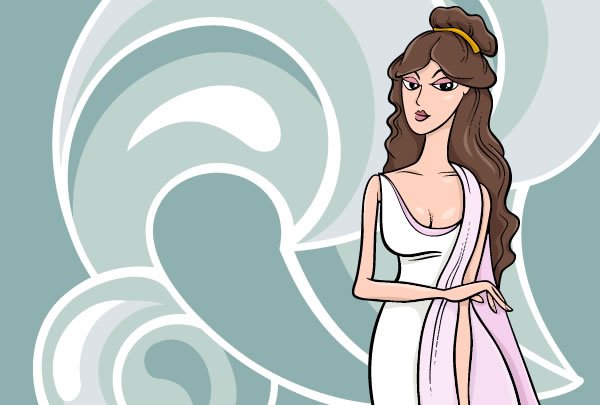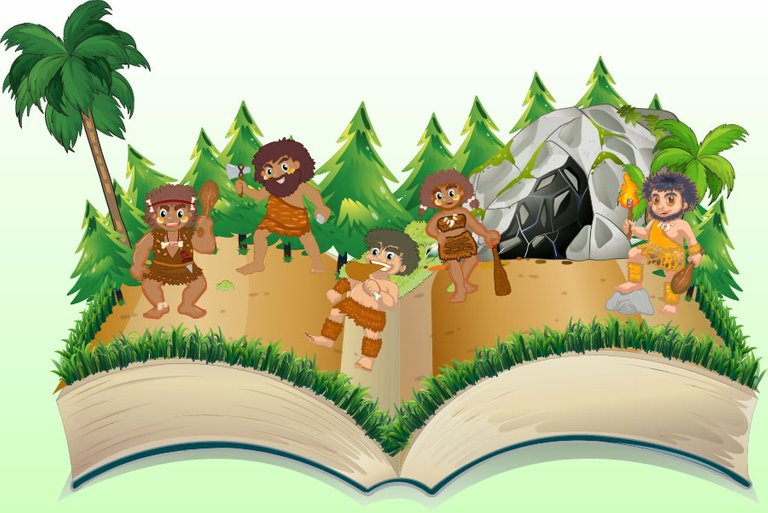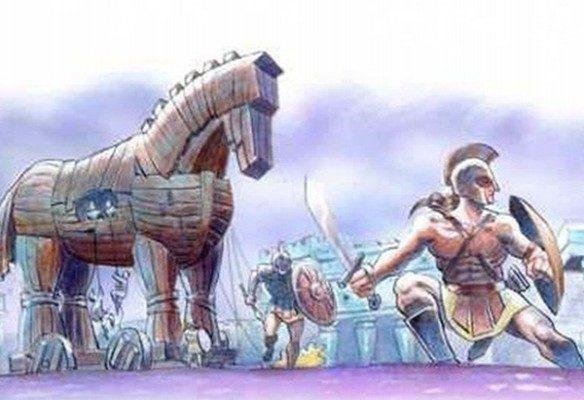
link
For younger children it is necessary to make a careful selection of their readings, where there is little text and large images, this will allow the child's attention to focus on the story as the adult develops the reading. Little by little the texts will be longer according to the age.
As I said in the previous chapter, legends constitute the transmission from generation to generation of the cultural wealth of peoples, with much or little proportion of imaginative elements, either orally or in writing, by involving children in this type of history in addition to classic stories, will motivate them to explore and root cultural values and traditions.
Here are some excerpts from these legends:
The Legend of the Sun and Moon
 )
)fuente
When the earth was in darkness; when it was always night, the mighty living in the sky gathered together to create the Sun and for there to be light on the Earth. They gathered in a city called "Teotihuacan" which was in the sky, and of which the city of "Teotihuacan" which is in Mexico was like a shadow or a reflection.
"The Sun and the Moon" is a Mexican legend that talks about the creation of the Sun and the Moon, two very important stars, an ancient story that helps stimulate the imagination of the child. The story takes place in the celestial city of "Teotihuacan" where it is said that they lit a huge bonfire and that mighty one who had great courage and was thrown into it would then be The Sun, the star king, there were two candidates, one rich, big, beautiful, who wore luxurious clothes, in addition he offered to his companions gold and other riches and the other on the contrary, poor, small, ugly, with torn clothes, but with good and humble intentions, only that he could offer, his courage was the great surprise because he threw himself to the bonfire to become the sun, while the rich man had repented minutes before.
Then when he saw it turned into a sun, he felt shame and decided to throw himself into the bonfire as well, another sun appeared in the sky, turned into a moon. It is for that reason that you can see the figure of a rabbit on the moon because it was who took away its light. This magical and fantastic story undoubtedly leads to fly the imagination of the little one and create in his mind the events for their descriptive feature.
The Fisherman and the Goddess : Children's legend

link
"Phaon" had been moved by his appearance and, forgetting his tiredness, he sailed his boat with an astonishing lightness. Thus, shortly after, they reached the coast of Asia. Once there, Phaon took out of his pocket the largest coin he had and handed it to the beggar so that he could continue the journey. - Thank you, boy. And for you to see my gratitude, take this gift.It was a glass of the most extraordinary perfume I had ever smelled. And with that mysterious perfume in his hands, "Phaon" was moved and trapped by a force that seemed to intoxicate his heart. And after this, the humble fisherman understood that he had taken Venus herself, the goddess of love, in his boat."
This legend refers to a fisherman who made many trips and for that reason was very resting when suddenly a beggar comes up to him and asks him to take her in his boat. The fisherman took her where she wanted without the woman offering her anything in return. When he arrived at his destination the fisherman had the generosity to give the poor woman the biggest coin he had and she in return gave him a glass of exquisite perfume, the best the man had ever smelled. At the end of the story the fisherman realizes that he had taken Venus, the goddess of love, in his boat.
In the same way this simple and short legend shows values such as solidarity, generosity and simplicity in the characters, reinforcing in the small feelings transparent and full of humility, undoubtedly a very good choice for the selection of readings of the child.
Legend "The inaccessible rock"

link
" When one day bad weather knocked down all those pillars that they had created and raised with so much effort, the primitive men were frightened thinking that the mountain had its own life and great powers. However, they never went any further or ever understood the true cause of the collapse, and such was the misunderstanding that, after many, many years, men lost their fear and again challenged and faced the same land."
Particularly one of my favorite legends, since it carries with it a great teaching for the little ones, besides being a text with a great descriptive content that allows us to imagine the landscape where history develops, it brings a reflection about the damage that man has done for millions of years to nature, when he was a primitive man, he wore furs and possessed axes. Although at first primitive man was frightened because he thought that the mountain in the story told had a life of its own because it destroyed what they built, as time went by his incomprehension made him continue to challenge it without fear, and today without skins or axes man continues to strip the earth of everything it possesses. That is why man is considered "the inaccessible rock" for the universe.
Legend of Robin Hood (children's adaptation)

link
"Since then Robin Hood practiced every day the archery which was his father's favorite tool, so Robin Hood could free his people from a long life of poverty and death by unnecessary famines. Robin stole from the rich every day and very rarely in the evenings. He doesn't do it more than twice in the same house because he doesn't want his people to live comfortably to the wealth of others so he only steals the necessary amount so that his people can stay alive and of which they are for vegetables, meats and medicines which are very necessary to take care of any wounded that come out."
One cannot fail to mention this wonderful legend, this character of Robin Hood also known as the "prince of thieves", is one of the best known in the legends of Western culture and has inspired various characters, one of them is Ghino di Tacco, Italian hero of the thirteenth century. The written records on Robin Hood have been located since the thirteenth century, obtaining more popularity from the fifteenth century.
The story tells that this marvelous character confronted the rich to defend the poor and took belongings from the wealthiest without them realizing it to give them to those who needed them the most; always accompanied by his green suit, bow and arrows.
There have been many investigations into the character of Robin Hood, many assure that his existence was true, but with other names. It is also said that he was the nephew of a blacksmith who was born around 1290.
It should be noted that in explaining the teaching of the legend to the children, it must be emphasized that the mission of this character was to be able to free his people from the life full of poverty they had had for a long time where even some died of hunger unnecessarily emphasizing the value of generosity and solidarity to those who need it most.
Legend The Trojan Horse

link
" A long time ago the first war happened which was the Trojan War. Greeks and Trojans fought over Helena, the most beautiful woman in the world. Helena was Greek, but a Trojan prince fell in love with her and took her to Troy. Some say that the Trojan prince kidnapped her, while others claim that it was Helena who wanted to go to Troy."
The Trojan Horse is a sign of teamwork, of union, to obtain an end or a reward, this emblematic legend focuses on a war for the beautiful Helena, which lasted many years and finally culminated in the construction by the Greeks of a wooden horse to enter Troy and rescue the beautiful lady.
An excellent option in the selection of readings for children are the mythological legends because in addition to showing the foundations of Western culture, also strengthen values such as effort, perseverance, humility, friendship, essential for their education, probably difficult to adapt these stories to children's age, however it is a good strategy for the child to know about history and enjoyment.
A selection of appropriate readings for children will allow, as was said at the beginning, the cognitive development of the same, also develops the ability to concentrate and memory, together with it the child can know the history, customs, traditions, ie enrich their culture according to the type of reading that is provided, their natural curiosity will lead to deepen even more and their creativity to imagine and produce according to their readings, is therefore the responsibility of parents and teachers to stimulate and create a habit of reading in the child considering the best and most suitable according to their need.
By: @luces
link consulted
link consulted
link consulted
Click on the coin to join our Discord Chat

Witness proposal is here:
Go To Steem Witness Page
In the bottom of the page type: adsactly-witness and press vote.

Use small letters and no "@" sign. Or, click here to vote directly!
Thank you!
Excellent post and excellent selection of legends and myth.
As a parent and teacher who specialized in children's literature I can attest to the power of literature (of any kind), espeially the one that stimulates children's imagination.
I have recently been working on a project, alongside some of my ex-students, now colleagues. We have been reading children's books in poor areas where children rarely receive that kind of stimuli.
We have also given away used books for them to own and share with their friends. Thus far it has been a very successful initiative.
(https://steemit.com/ulog/@hlezama/ulog-048-giving-back-to-a-community-left-behind).
I think that one of the key aspects in promoting this kind of literature is that it is a vital part of global culture. It gives kinds who are exposed to it the upper hand in developing language, cultural awareness, and critical thinking. Stories like the Trojan Horse or Robbin Hood are part of the world langauge and carry additional meanings in political, economic, and even psychological contexts. By being exposed to these stories at early age, children have the possibility of catching up with trends and ideas and develop faster the skills they'll need as grown-ups.
I LOVED these sort of legends and tales as a child @adsactly . I had ancient parents and even older Grandparents and they'd tell wonderful stories that would not be seen as 'appropriate' for children today. And I grew up on old Victorian children's books full of lessons that had children loosing limbs or being lost if they did or did not do something. I loved it all.
On a personal level and as a teacher, I also believe that reading is fundamental for a child's cognitive growth. A child who grows up listening to stories is a child with a lot of imagination and creativity. The detail is to know what kind of stories to read to them, what kind of values or feelings we want to reinforce. Sometimes that selection can be difficult. Stories with the image of the hero can sometimes be counterproductive, especially when in our country, Venezuela, the image of the hero is undervalued. The idea of a hero who steals from the rich to give to the poor, I don't know how good he is these days. From there to justifying any action of corrupt politicians who steal with the tale of helping the poor, there is only one step. It has to be said: Stealing is bad, without any excuse. Thank you for this post, @luces.
Creating the interest and habit of reading among children and adolescents is an indispensable task in emotional and intellectual formation, which, therefore, should be permanent in parents or family in general, in school and cultural centers; also in media such as TV. For this it is necessary that the family (parents, siblings), teachers and cultural promoters have the habit of reading and can be updated.
Myths and legends are very rich material; there are specialized books that make selections and appropriate versions for children. If parents and educators are good readers of these original stories, they could make their own oral versions and tell them to the younger ones.
The first story you present is the one I appreciate the most; in reality it is not a legend, but a Nahuatl myth, very beautiful and with deep meanings. The history of the Trojan horse and that of Robin Hood are well known, and have an indisputable value. The story of the fisherman and the goddess did not know it; it is also a very beautiful story.
Now, all these and others require parents, above all, with some training, which allows for broad and proper guidance in their work of interpreting the stories for children.
Thank you for your gratifying post, @luces. Greetings.r
Hi, @adsactly!
You just got a 0.39% upvote from SteemPlus!
To get higher upvotes, earn more SteemPlus Points (SPP). On your Steemit wallet, check your SPP balance and click on "How to earn SPP?" to find out all the ways to earn.
If you're not using SteemPlus yet, please check our last posts in here to see the many ways in which SteemPlus can improve your Steem experience on Steemit and Busy.